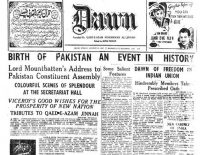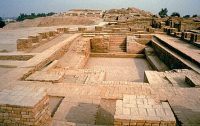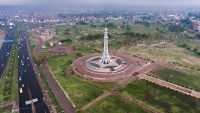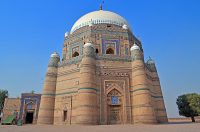History Of Uch Sharif Pakistan
Uch Sharif is a small town located at the edge of the Cholistan Desert in Bahawalpur District, approximately 61km southeast of Bahawalpur City. The Sutlej River joins the Chenab River just a few kilometers north of Uch Sharif while Panjnad is located a few kilometers southeast of Uch Sharif.
At one time, Uch was a thriving metropolis, an important inland port, and a refuge for Central Asian migrants who fled the Mongol invasion.In the 12th and 13th centuries, many famous Sufis chose to settle here. Today the town can be divided into three distinct neighborhoods: Uch Mughlia, Uch Bukhari, and Uch Gilani. Uch has retained not only its traditional character, but also historical monuments that are some of the finest pieces of architecture in Pakistan. It attracts people from all over who come to pay their respects throughout the year and in large numbers during the annual week-long urs.

Uch has an ancient history. Close to 4000 BC, the Aryans arrived in Uch. It is likely that they named it Ushas after one of their goddesses, and later Ushas was changed to Uch. In the 5th and 4th centuries BC, the Achaemenid Empire of Persia controlled Uch along with most of Punjab and Sindh. In 326 BC, Alexander the Great built his city, Alexandria-Ussa, just near to the point where the Indus and Sutlej Rivers joined.Uch is sometimes identified with Alexandria-Ussa, but due to the changing course of the Indus over the centuries it is not verifiable. For a short while Uch remained under Greek rule, but shortly after the Mauryans took control of the region, and subsequently the Parthians and Kushans.
Not much is known about Uch for the next thousand years until it came under the control of Muhammad Ghauri in 1175. Nasir al Din Qabacha was given the governorship of the Multan region and under his rule, Uch experienced its golden era. It became a major city and was renowned as a center of scholarship and arts. Qabacha built colleges, sarais, and khanqahs. Many famous scholars came to Uch from far away lands. During the Mongol invasion of Central Asia, prominent Muslim families fled south and many found a home in Uch. During this time, the Firozi College was established in Uch, which could admit 2,500 students at one time.
In 1228 AD, the Sultan of Delhi, Shamsuddin Iltutmish, managed to defeat Qabacha’s forces and Uch came under the dominion of the Delhi Sultanate for the next few hundred years. During the Khilji rule, the Mongols raided the subcontinent and came as far down as Uch. The Sultan made a peace treaty with them and married one of his daughters to a Mongol chief. Some of the Mongols chose to stay in the outskirts of Uch and even today this neighborhood is known as Uch Mughlia.
Towards the end of the 15th century, Rai Sahna of the Langah tribe, ruled independently in the areas of Multan and Uch, followed by the Arghuns of Sindh, and later the Mughals. It was the Mughals who commissioned the beautiful monuments that are the very trademark of Uch. Many of the tombs of Sufi Saints were built during this time. Eventually the Nawabs of Bahawalpur took charge of this area. Uch remained a part of the Bahawalpur State until it joined Pakistan after Partition.

Two major monument complexes are situated in Uch. Both complexes are in deteriorating state and have been partially destroyed by floods. The Jahanian Jahanghasht complex contains four tombs, two mosques, and a madrassa. One of the tombs is that of Jahannian Jahanghast, a famous Sufi of the 12th century who wandered the world but finally settled in Uch.
The Surkh Bukhari complex contains four tombs, a mosque, and a graveyard. These tombs are considered to be some of the finest pieces of architecture in all of Pakistan.
The tombs are usually square or octagonal in shape and are decorated with glazed tiles. The tiles are mostly white, blue, turquoise or cobalt in color. Panels of glazed tiles are usually intersected with bricks. Floral motifs and geometrical patterns are the dominant designs formed by the glazed tiles.Inside the tombs, the roofs are often decorated with multicolored floral and geometric patterns on lacquered wooden ceilings.
Born in Bukhara (modern day Uzbekistan) in 1199, Jalaluddin Bukhari came to Multan at a young age to learn from Bahauddin Zakariya of Multan. He was a travelling Sufi who converted many of the tribes in Sindh to Islam including Talpur, Soomro, Samma, and Sial. He finally settled in Uch in 1244. Upon his death he was buried in Sonak Bela, near Uch, but due to nearness of the river, his family moved his remains to Uch. His remains were removed for the second time to their present site where the Nawab of Bahawalpur built his tomb. A yearly urs takes place here.








Leave A Comment